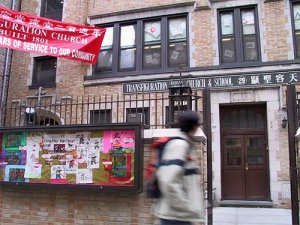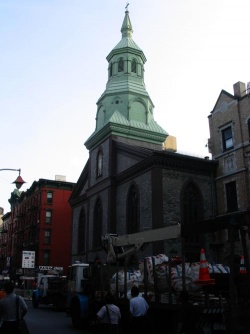The Transfiguration ChurchFrom The Peopling of New York CityThe Transfiguration Church Image courtesy of nychinatown.org. The Transfiguration Church stands on the curve of Mott Street, austere amongst colorful street awnings, its green bell tower rising in sharp contrast to the brown brick buildings. Built in 1801, the church is truly a church of immigrants, first serving the Irish, then the Italians, and finally, the Chinese. After the wave of Chinese immigrants, the church is now primarily Chinese, and indeed, it is now the largest Chinese Catholic church in the country. The church has adapted to each influx of foreign-born members, now offering sermons in Cantonese, Mandarin and English. Sunday Mass usually attracts close to nine hundred people, not just from Chinatown and Manhattan, but from Queens and Brooklyn as well. Reverend Raymond Nobiletti has been pastor of the Transfiguration Church for eighteen years. He speaks Cantonese and Mandarin, as well as English. He has been a part of the Transfiguration Church since 1991, has seen Chinatown evolve and grow and change all around him. Still, even as each wave of immigrants assimilates into American culture, a new wave comes to take its place. Most recently, it is the Fujianese, who speak a different dialect of Chinese altogether. But Reverend Joseph Lin speaks four languages, and comes from the Fujian Province, which means he is able to accommodate the newest wave of Chinese immigrants. Image courtesy of bridgeandtunnelclub.com.
After the events of 9/11, however, Chinatown, with its proximity to the World Trade Center, experienced major setbacks from which it has yet to fully recover. Streets were closed off, phone lines went down, and tensions ran alarmingly high. Nevertheless, the church persevered and is doing exceptionally well. Despite economic setbacks to the entire Chinatown area, the church and school manage to stay afloat, and there is no shortage of members or students. The Transfiguration Church is a focal point for the Chinatown community, especially in times of hardship and struggle. There is a sense of togetherness that the church fosters, allowing its members a place to gather and to build lasting relationships that will help them through the many trials of life. |